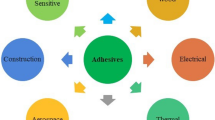Abstract
The possibility of immobilizing bactericides on PET fibres by the craze formation mechanism was demonstrated. Of the bactericides investigated, Al (althosan) was a more active modifier of the fibres than Ct (catamine). The resistance of the bactericidal fibres to “wet” treatments simulating laundering conditions was demonstrated, and this allows using fabric articles made from them for a long time.
Similar content being viewed by others
References
T. N. Kudryavtseva, LegPromBiznes-Direktor, No. 5 (55), 29–31 (2003).
M. V. Gorlenko (ed.), Microorganisms and Lower Plants — Destroyers of Materials and Products [in Russian], Nauka, Moscow (1979).
M. Ash and I. Ash (eds.), Handbook of Plastic and Rubber Additives, 2nd ed., Synapse Inform. Res. Inc., New York (2003).
M. Ash and I. Ash (eds.), Handbook of Plastic and Rubber Additives, 2nd ed., Synapse Inform. Res. Inc., New York (2002).
V. P. Sklyannikov, Consumer Properties of Textile Goods [in Russian], Ekonomika, Moscow (1982).
G. E. Afinogenov and E. F. Panarin, Antimicrobial Polymers [in Russian], Gippokrat, St. Petersburg (1993).
I. V. Borisevich, N. S. Vinidiktova, et al., Plast. Massy, No. 8, 35–40 (2005).
A. L. Volynskii, N. V. Bakeev, et al., Vysokomolek. Soedin., 42A, No. 6, 988–993 (2000).
K. E. Perepelkin, Khim. Volokna, No. 5, 8–18 (2001).
K. E. Perepelkin, Structure and Properties of Fibres [in Russian], Khimiya, Moscow (1985).
A. L. Volynskii, O. V. Arzhakova, et al., Vysokomolek. Soedin., 44C, No. 9, 1701–1719 (2002).
A. A. Abramzon, V. V. Bocharov, et al., in: Surfactants: A Handbook [in Russian], A. A. Abramzon and G. M. Gaevii (eds.), Khimiya, Leningrad (1979).
M. A. Martynov and K. A. Vylegzhanov, X-Ray Dijfractometry of Polymers [in Russian], Khimiya, Leningrad (1972).
G. I. Kagan, N. N. Zhegalova, and B. V. Vasil’ev, Automated Method of Determining the Degree of Crystallinity of Polymers with Data from an X-Ray Diffraction Experiment. Physical Methods of Investigation [in Russian], Book 3, Vysshaya Shkola, Moscow (1987).
L. L. Razumova, T. E. Rudakova, et al., Vysokomolek. Soedin., 14A, No. 4, 861–864 (1975).
R. P. Daubeny, C. W. Bunn, and C. J. Brown, Proc. Roy. Soc. A., 226, 231–242 (1954).
Yu. A. Tomashpol’skii and G. S. Markova, Vysokomolek. Soedin., 6A, No. 2, 274–280 (1964).
A. Z. Skorokhod, I. S. Sviridova, and V. N. Korzhik, Mekh. Kompozitn. Mater., 30, No. 4, 455–463 (1994).
Polypropylene [Russian translation], Khimiya, Leningrad (1967).
L. L. Mironovich, E. V. Gartman, et al., Mater., Tekhnol., Instrumenty, 9, No. 1, 68–72 (2004).
Author information
Authors and Affiliations
Additional information
__________
Translated from Khimicheskie Volokna, No. 5, pp. 34–38, September–October, 2006.
Rights and permissions
About this article
Cite this article
Vinidiktova, N.S., Borisevich, I.V., Pinchuk, L.S. et al. Modification of poly(ethylene terephthalate) fibres with bactericides with the craze formation mechanism. Fibre Chem 38, 387–391 (2006). https://doi.org/10.1007/s10692-006-0096-y
Issue Date:
DOI: https://doi.org/10.1007/s10692-006-0096-y




